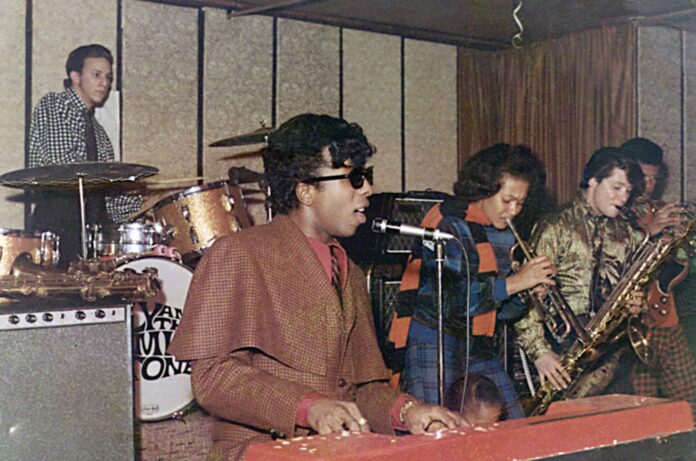Released in the latter part of 1967, A Whole New Thing, the debut record by Sly and The Family Stone for Epic/CBS Records, was a direct account of where Bay Area multi-hyphenate producer, DJ, musician, and creator Sly Stone was traveling at the time. The LP moves fluidly through rock, R&B, funk, and psychedelic circlesto Sly, as always, it was just music.
In the joyous overshare documentary by Questlove, aka Ahmir K. Thompson, Sly Lives! (aka the Burden of Black Genius), available on Hulu, we find out that Sly was Grace Slick’s first producer. Yes, he built and assisted on “Someone to Love,” later famously covered by Jefferson Airplane but originally recorded by The Great Society, with Sylvester Stewart providing the band with suggestions on how to improve the track. Sly also helped in production for a pre-fame version of the Grateful Dead, back when they were known as the Warlocks in the early 1960s.
Upon release, Sly and The Family Stone’s debut record did not fare so well. Critics and music fans were confused, befuddled. It failed to make a commercial dent. But it’s deeper than that. The reason hit me about 28 minutes into a third viewing of this glorious Sly doc.
I interviewed funk genius George Clinton in the early ’90s over the phone, straight-up fanboying out because, hey, it’s freakin’ George Clinton. I had to fax him 10 trial questions and then wait, hope, and pray he would call me back. Which he did. Off top, he made sure to tell me to address him as “George”. Man, I was fanboying like a mug. Asking questions about why you can no longer find Quaaludes. Did P-Funk really get paid half in cash and half in cocaine for the Mothership connection tour in 76? (The answer was yes…)
He’s telling early stories about Parliament, Funkadelic, the band taking acid and performing in just sheets and sometimes buck naked, but then, he hit me with the quote that explains everything: At the time, we were too white for Black and too Black for white.
And there it is, in red, white, and truth.
There is a track on Sly’s debut, “Trip to Your Heart,” that is a psychedelic, trippy rock, funk express. A straight-up out-there cut that cooks. That intro? Eventually used for LL Cool J’s golden hip-hop anthem “Mama Said Knock You Out.” With the bass drum kick on delay, vocal lines swirling, and horns advertising this hybrid concoction, it’s Beach Boys’ Pet Sounds worthy. Just that undeniable. But for a Black artist in 1967, it doesn’t quite register with pop music. During the same year, The Beatles released not one, but two psychedelic-tinged records, both inspired, mind you, by Beach Boys’ Pet Sounds. Sgt. Pepper’s Lonely Hearts Club Band (the Beatles were allowed to, and by the way, celebrated when they became an actual other band) and the EP soundtrack, Magical Mystery Tour. Both reek of massive studio knob-twisting and alternative recording methods that remain lauded as genius, big-brained rock explorations.
But after Sly’s flop—excuse me, misfire—that also involved some major knob-twisting, record executive Clive Davis instructed Stone to create a more “commercial album,” and “Dance to the Music” was born.
Sly and The Family Stone served as the house band at Redwood City, California’s Winchester Cathedral from December 16, 1966, to April 28, 1967, lighting up the club with their dynamic, crowd-pleasing performances. The First Family: Live at Winchester Cathedral 1967, to be released on July 18, was recorded in the early hours of March 26, 1967, by Sly and The Family Stone’s first manager, Rich Romanello. Upon the group’s signing to Epic Records later that year, Romanello put the seven-inch analog tapes into storage, where they sat for 35 years. The reels were rediscovered in 2002 by Dutch twins Edwin and Arno Konings, renowned Sly and The Family Stone archivists, and carefully restored by their co-producer Alec Palao for the new release.
This is a revealing album, showcasing what Sly was able to do with this multi-gendered, racially mixed band lineup. One “so future” (to quote Andre 3000) that moved fluently from R&B covers to original arrangements, unique with all the voices, energy. Here is early wit and flair from the man Miles Davis feared would one day figure out jazz and put him out of business.
The same Sly cleverly maneuvered by placing the drum machine at the core of a rhythm section on “Family Affair.” The song’s recording process was fraught with challenges, according to producer and musician extraordinaire Bill Laswell, as told to me in a phone interview, Sly was working on it so long that the tapes started shredding and falling apart from overdubs, so the end result was this really raw sound with Sly playing bass on a lot of the record.
The, again, same Sly Stone had so great an influence that he wasn’t even in his bed at The Record plant in Sausalito when itplayed a significant role in Stevie Nicks writing the Fleetwood Mac song “Dreams” in about 10 minutes. She was inspired by a drum loop and created the song while the rest of the band worked on instrumentals. “I sat down on the bed with my keyboard in front of me,” continues Nicks. “I found a drum pattern, switched my little cassette player on, and wrote ‘Dreams’ in about 10 minutes. Right away, I liked the fact that I was doing something with a dance beat, because that made it a little unusual for me.”
According to the New York Times, Sylvester Stewart was born in Denton, Texas, on March 15, 1943, the second of Alpha and K.C. Stewart’s five children. Soon after, the family moved west to Vallejo, California, north of San Francisco, where Mr. Stewart worked as a cleaner and in maintenance at a department store. The couple raised their children in the Pentecostal church, where they first became immersed in music.
With the passing of Sly Stone on June 9, at the age of 82, the accolades and tributes have flowed nonstop from everyone who has an internet connection. From tabulations on how many times his discography has been repurposed, the top five, 10, 15 best-known Sly songs, how many attempts he made to restart his career over the decades, to the musical lineage he began.
As Questlove put it so succinctly in Rolling Stone recently, we look to Stevie Wonder and Prince, but “Sly created the DIY, all-in-one genius lane that Stevie Wonder, Todd Rundgren, Prince, and Shuggie Otis would not only follow, but also build empires on. There is a playful freedom that dances somewhere in between “wow this is serious!!!” And “wait—is he serious?” And “uh….he can’t be serious.”
But there is a philosophy at play from the onset of his creative work, something optimistically American that he bought into—-perspective his father found hard to have, having suffered the injustices of Jim Crow racism. Sly believed in the inclusion of all those voices, perspectives, ideas, and most importantly, frequencies–the rate at which waves, like sound waves or light waves, oscillate. He knew there was condensed information in the way that energy traveled, and the more you can combine it with others, the more ears you will ultimately reach.
In the Summer of Soul doc, when Sly and the Family Stone walk out on the Harlem Cultural Festival stage in their San Francisco street clothes, with a white drummer, and a Black woman playing trumpet, to earn their $2500, New York City, Harlem World Black card respect, in preparation for their career-changing Woodstock performance. Everyone at the show under 25 understood the cultural change that was happening in real time. Those over 25, looking at these West Coast hippie freaks, without onstage uniforms—well, they needed a couple of songs to get with the new program, but eventually they got it too.
It’s mournfully ironic that Sly & The Family Stone’s The First Family: Live at Winchester Cathedral 1967 would materialize now, but it was indeed a warning shot that a musical riot, never heard before, was about to launch.
Stream The First Family: Live at Winchester Cathedral 1967 here.





